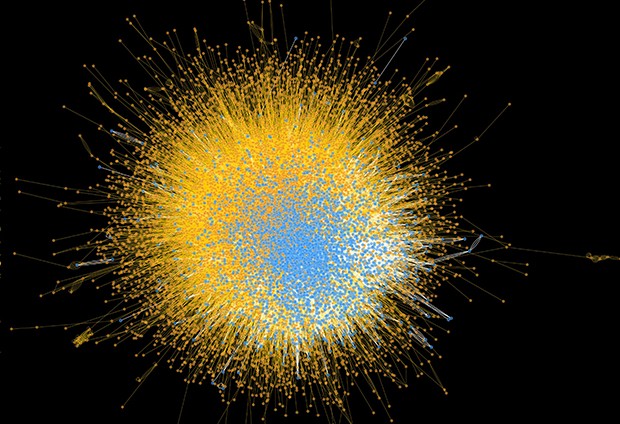
500,000 binary interactions… and growing
Building and visualising protein-interaction networks is easier and more accurate thanks to IntAct, a public database of 500,000 molecular interactions.

More than half a million experimentally determined protein interactions are freely available in EMBL-EBI’s IntAct database, providing a means to build and visualise the network of protein interactions at play in living things. This public data resource continues to grow thanks to experimental data submitted directly by researchers, and is bolstered by data captured from the scientific literature.
Capturing protein interactions
Biological processes are governed by the act of molecules communicating through physical contact. Such contact could be anything from transient interactions, for example those involved in synapse signalling, to the well-orchestrated organisation of protein complexes. It would be impossible to study the biology of a protein without looking at the molecules with which it binds – or to understand how a cell works without knowing which protein networks drive and regulate its myriad processes.
IntAct, the public database of molecular interactions, collects experimental evidence of proteins interacting with other proteins, of transcription factors associating with gene-promoter regions, and of biologically active small molecules binding to their target. It also offers an increasing number of RNA interactions, referencing the new RNAcentral resource.
“All of these datasets are checked carefully by our biocurators before each release of IntAct,” explains Sandra Orchard, IntAct Project Leader at EMBL-EBI. “This means that users can be confident that they are accessing the highest-quality information. Also, they can download the datasets in community-standard formats, so it’s easier to analyse the data in different visualisation and analytical platforms. For example, you can build an interaction network specific to your work using the IntAct search tools, and then integrate it with other data types in Cytoscape, a popular visualisation program.”
A collaborative resource
IntAct is a member of the IMEx Consortium, a partnership of several interaction databases that work together to provide a non-redundant set of consistently annotated protein interaction data.
IntAct is a unique resource for systems biology – there is really nothing else like it.
Collaborations between IMEx members have led to substantial growth of public interaction resources. For example, a detailed representation of the recently published dataset, ‘A proteome-scale map of the human interactome network’, has been captured by collaborators in EMBL-EBI’s IntAct team and the Center for Cancer Systems Biology (CCSB) at the Dana-Farber Cancer Institute in Boston, MA. This dataset significantly increases the coverage of the network of human protein interactions by the IntAct database.
“IntAct is a unique resource for systems biology – there is really nothing else like it. This milestone for the project represents a massive effort, not just for the people curating and hosting the data at EMBL-EBI but the many experimentalists who have worked so hard to establish the exact nature of thousands of molecular interactions,” says CCSB Director Marc Vidal.
In 2013, collaborators at IntAct and the MINT database at the University of Rome, Italy produced a single merged dataset, which continues to grow thanks to curators in many groups throughout the world. These include the UniProt Consortium, MatrixDB, I2D, InnateDB, MBInfo, the UCL Cardiovascular Gene Annotation, AgBase, Molecular Connections and the Norwegian University of Science and Technology.
Future challenges
Advances in cell biology are leading to profound changes in the way we look at molecular interactions, and to keep up we need to find more sophisticated ways of representing the network of interactions that direct and modulate cellular processes. The IntAct model enables curators to capture information such as the effects of mutations or protein modifications on interaction networks, which is a good starting point. But this information needs to be more fully utilised to help explain, for example, the effects of single amino acid variants on disease pathology. Emerging techniques for studying interactions are generating increasing amounts of biological information, which must be systematically captured if it is to be of use.Notes for editors
Note for editors
About IntAct
Produced at EMBL-EBI, IntAct is a freely available, open-source database of molecular interactions that offers a suite of analysis tools. The interactions are derived from literature curation and direct user submissions. IntAct is an international effort, with contributors at MINT (University of Rome), UniProt (EMBL-EBI and the SIB-Swiss Institute of Bioinformatics), MatrixDB (University of Lyon), I2D (University of Toronto), InnateDB (Collaborators in Australia, Canada and Ireland), MBInfo (National University of Singapore), the Functional Gene Annotation group at University College London, AgBase Host-Pathogen Interaction Database (Mississippi State University), Molecular Connections Ltd. (India) and the Norwegian University of Science and Technology. IntAct is funded by the Biotechnology and Biomedical Sciences Research Council (MIDAS grant BB/L024179/1), the US National Heart, Lunch and Blood Institute (Proteomics Center Award HHSN268201000035C), the European Commission (Affinomics grant FP7-241481) and The Michael J. Fox Foundation for Parkinson’s Research (LRRK2 Biology LEAPS).
About IMEx
The IMEx Consortium is a network of major public-domain databases that work together to provide a non-redundant set of expertly curated protein–protein interaction data from organisms across the taxonomic space. Members include IntAct at EMBL-EBI, MINT, DIP (University of California Los Angeles), UniProt, MatrixDB, I2D, InnateDB, MBInfo, the UCL Functional Gene Annotation group and Molecular Connections Ltd. IMEx is funded by the Biotechnology and Biomedical Sciences Research Council (MIDAS grant BB/L024179/1).
This post was originally published on EMBL-EBI News.


